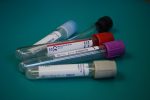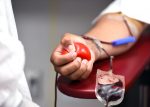
As a child, I had severe allergies that led to me receiving a few rounds of allergy shots.
These injections contained antibodies related to the allergens I tested positive for, and there were quite a few.
I hated the shots, but I learned a lot about phlebotomy as my guardian gave me the injections at home.
If you are interested in drawing blood, specifically, in relation to injections, then phlebotomy is the career choice for you.
Here is a guide on online phlebotomist certification and training courses around the US to get you started on your occupational journey.
Page Navigation
- What Courses Are in an Online Phlebotomist Program?
- Can You Earn a Phlebotomist Certification Completely Online?
- How Long Does it Take to Earn a Phlebotomist Certification Online?
- How Much Does an Online Phlebotomist Certification Cost?
- Benefits of Online Phlebotomist Training Programs
- Drawbacks of Online Phlebotomist Training Programs
- Benefits and Drawbacks of Online Phlebotomist Training Programs – Summary Table
- Types of Phlebotomist Certifications
- 4 Self-Study Tips for Phlebotomist Online Students
- Summary
- Frequently Asked Questions
What Courses Are in an Online Phlebotomist Program?
An online phlebotomy program covers all of the necessary training in a phlebotomy field of study.
Maybe you are interested in working hands-on with taking blood as a phlebotomy technician.
Or perhaps you are more curious about tools used for monitoring blood samples as a phlebotomy technologist.
Whatever area of phlebotomy science you want to study and work in, there are training programs online for all types of phlebotomists.
Can You Earn a Phlebotomist Certification Completely Online?
Yes, you can earn a phlebotomist certificate completely online with several training centers and colleges.
The certificate program covers all of the necessary skills and tasks associated with working as a phlebotomist.
From there, the certification requirements include sitting for a board exam for phlebotomist technician or phlebotomist technologist certification.
To sit for an exam requires students to take a certification exam focused on phlebotomy.
This is also available completely only for students in phlebotomy training.
How Long Does it Take to Earn a Phlebotomist Certification Online?
It typically takes less than one year to earn a phlebotomist certificate online.
In most cases, students spend a week to two months practicing and studying phlebotomy in a remote learning environment.
From there, the student must pass a certification exam in order to become a professional phlebotomist.
How Much Does an Online Phlebotomist Certification Cost?
Online phlebotomy certification involves two areas for cost.
First, you have the study and training to become a phlebotomist.
This costs, $300 to $700 in most cases, for online training.
If you go to school in person, the tuition costs will skyrocket in comparison between $600 to $2,500.
Second, there are the costs for certification exams.
Each of the major certification exams for phlebotomy costs $100 to $180 to take once.
Benefits of Online Phlebotomist Training Programs
Ease of Phlebotomy and Blood Work Training
If you struggle with in-class training programs, the remote learning provided by 100 percent online training is the better option.
Whether you have anxiety or are too busy to go to school, online training for phlebotomist students works in your favor.
Save time and work on your schedule, and become trained as a certified phlebotomist in no time.
Compare this to the traditional setting of a college where the school only operates on the semester system.
With an online training program, you get to choose your first day of school and the time you plan to attend.
Cost for Programs in Phlebotomy
The cost of attending an online training program for phlebotomy is much cheaper than that of a traditional in-person school program.
As a result, the savings are passed down to you as a student in the online training program.
If you have spent all of your financial aid on undergraduate college in the past, the online options for training are much more affordable and easier to take care of as a student.
Certification is Made Easier
Along with 100 percent online training, students can also sit for board exams online as well.
The streamlined experience helps many students who are studying online for the exam to do well.
They are able to take the certification exam from the same computer and home office setting.
Everything the student needs to help them focus on taking and successfully passing the certification exam is readily available.
This includes unexpected distractions, such as other students in a computer lab, that could cause a student to fail.
Drawbacks of Online Phlebotomist Training Programs
Lack of In-Person Training Opportunities
At the same time, when you work on the computer to train as a phlebotomist, you miss out on that human element.
Instead of getting hands-on with other students to learn about blood tests and using needles, you are left to your own devices.
This can be the biggest difficulty and barrier for students using online programs for training.
Needs More Hands-On Experiences
Phlebotomy is an area of healthcare that involves hands-on interaction with patients on a daily basis.
As a result, you should have some of this type of interaction with an online training program.
Yet, most of the 100 percent remote phlebotomy training opportunities do not have hands-on training.
In order to receive a clinical opportunity, you have to find that on your own.
This is a struggle for students who need that in-person experience as a phlebotomist.
You may miss out on the techniques and skills needed for sitting on boards, as well as for when you are hired in the workplace.
Unable to Network
In the healthcare industry, finding a job requires networking.
You need to know what jobs are available as soon as they are open, and having connections to help you do this is why networking is so crucial for any industry.
As a phlebotomist, you want to know other phlebotomists who can increase your chances of being chosen for one of those jobs, as well.
This may be true using one of these phlebotomists for a letter of recommendation or as someone to contact on a job application.
When you train 100 percent online, you do not make those same networks that are there to give you contact information that you can depend on.
Benefits and Drawbacks of Online Phlebotomist Training Programs – Summary Table
| Benefits of Online Phlebotomist Training Programs | Drawbacks of Online Phlebotomist Training Programs |
|---|---|
| Ease of Phlebotomy and Blood Work Training | Lack of In-Person Training Opportunities |
| Cost for Programs in Phlebotomy | Needs More Hands-On Experiences |
| Certification is Made Easier | Unable to Network |
Types of Phlebotomist Certifications
There are several phlebotomist certifications that students can take exams for in order to receive a certificate.
This certificate is needed when individuals prepare to become licensed in the industry.
A phlebotomy certificate is also important for employment purposes as proof of education and experience as a phlebotomist.
Some of the most recognized phlebotomy certificates are by associations and organizations.
These professional phlebotomy technician certifications include:
- American Medical Technologists (AMT) Phlebotomy Technician (RPT) certification exam for $125
- American Society for Clinical Pathology (ASCP) Board of Certification (BOC) Phlebotomy Technician PBT(ASCP) exam for $135
- National Center for Competency Testing and Competency Testing Phlebotomy Technician (NCPT) exam for $119
- National Healthcareer Association’s Certification Phlebotomy Technician (CPT) exam for $117
- National Phlebotomy Association (NPA) Certified Phlebotomist Technologist exam for $170
4 Self-Study Tips for Phlebotomist Online Students
Get an Orange
An orange or a lemon is a great tool for a phlebotomist student who is doing their needlework.
The soft skin is dimpled, similar to the way flesh is textured, and you can poke a needle in the fruit many times.
This is a good method for developing the hand-eye coordination needed to take blood–except that you are drawing the morning OJ at this point.
If you are going to school remotely using 100 percent online training for phlebotomy, this is an excellent tool for practicing drawing blood and using needles.
Work on Organizational Skills
As a phlebotomist in the field, you will be expected to label blood for testing and processing.
One of the biggest problems on the job is mislabeling blood work.
Since all blood samples tend to look the same visually, and blood test results most often involve life-threatening conditions, accurate labeling practices are super important.
Even though you are working online to train to be a phlebotomist, you will be working with handwriting on the job.
Practice lettering and understand how to spell correctly when writing by hand on patient records and labels.
You will use this skill as part of your job tasks.
Handwriting on labels can also help you increase your potential when getting hired by your first employer as a phlebotomist.
Get Blood Tested Yourself
And consider giving blood as a donation to a place like the American Red Cross.
By being a patient in the seat of a phlebotomist-trained person, you understand what the job will be like when you are taking someone else’s blood.
This is also an important aspect of being a phlebotomist–understanding the benefit of giving blood to save the life of others.
Also, going out into the world while doing online training and performing a phlebotomy-related activity will help you better understand your career goals.
You can also list that you have volunteered to give blood, and you might be able to secure a volunteer position as a phlebotomist at the ARC.
Either way, giving back with blood is a good move when you are planning on being a phlebotomist.
Increase Physical Stamina
Yes, you can take 100 percent online phlebotomy training certification courses.
However, you will be required to get up and on your feet in the real world of phlebotomy.
Once you begin your first job in phlebotomy, you will have to stand up and walk around for long periods of time.
You will also need to be in good physical shape to manage the dexterity and compassion it takes to be a professional phlebotomist.
A lot of people squirm around needles and most do not enjoy getting their blood drawn.
This is when you must go above and beyond most professionals in finding ways to get the patient to relax so you can stick them with a needle.
Summary
There are many jobs in the healthcare industry that involve phlebotomy.
However, only four states require certification, which makes this one of the easier jobs for entering the healthcare industry.
As a result, students need to pursue certification and get licensed before trying to find a job.
This will increase their likelihood of getting hired based on qualifications in this high-demand medical field.
Frequently Asked Questions
Where do phlebotomists work in the healthcare field?
The most common places for phlebotomists to work when they are in the job market are blood donation centers, hospitals, medical laboratories, and health clinics.
In any place that requires blood drawing or blood testing, phlebotomists can find employment.
Private doctors and nurses, as well as pain management offices, also have phlebotomists on staff.
Which states require phlebotomy certification?
Only four states in the US, including Washington, California, Nevada, and Louisiana, require certification as well as licensing for phlebotomists.
The rest of the nation hires phlebotomists without documentation of training, but there are other requirements.
For instance, in Alabama, phlebotomists must have proof of training, which can be a certificate or degree.
If a phlebotomist receives training and certification and moves to a new state of residence, they will most likely need to register or certify with that state to get hired in the new state.
What skills are most important for those individuals who are becoming a phlebotomist?
To be a successful phlebotomist, an individual must be comfortable with seeing and drawing blood using needles.
This is used for blood tests and blood transfusions, such as during surgery, as well as for conducting research using blood.
Skills needed for this position also include customer service and medical privacy for patients.
Phlebotomy is a medical occupation that involves stringent controls and restrictions.
As a result, phlebotomists must be professional about their job and patients.
This includes handling work-related information, as well as data for patients and the medical industry.
What is the job outlook for phlebotomists in the US?
The US Bureau of Labor Statistics (BLS) reports a positive job outlook for phlebotomists: “About 19,500 openings for phlebotomists are projected each year, on average, over the decade.”
The openings are expected to come from retired phlebotomists and those who transfer to other jobs.
The predicted job rate for this occupation is growing much faster than average.
From 2020 to 2030, there is an anticipated 22 percent increase in the number of job openings available for phlebotomists.
As a result, it is a favorable time to enter the job market as a phlebotomist.








